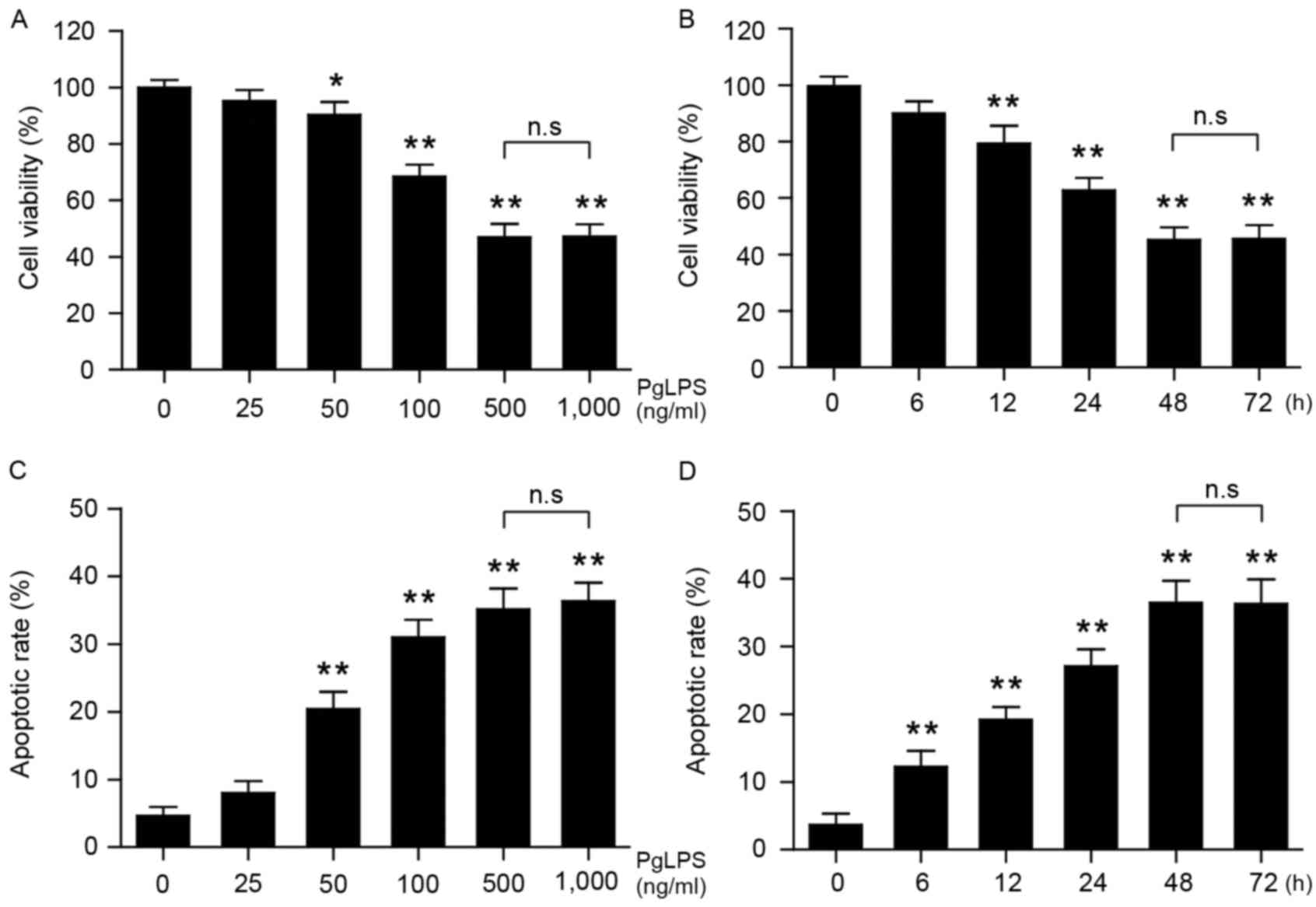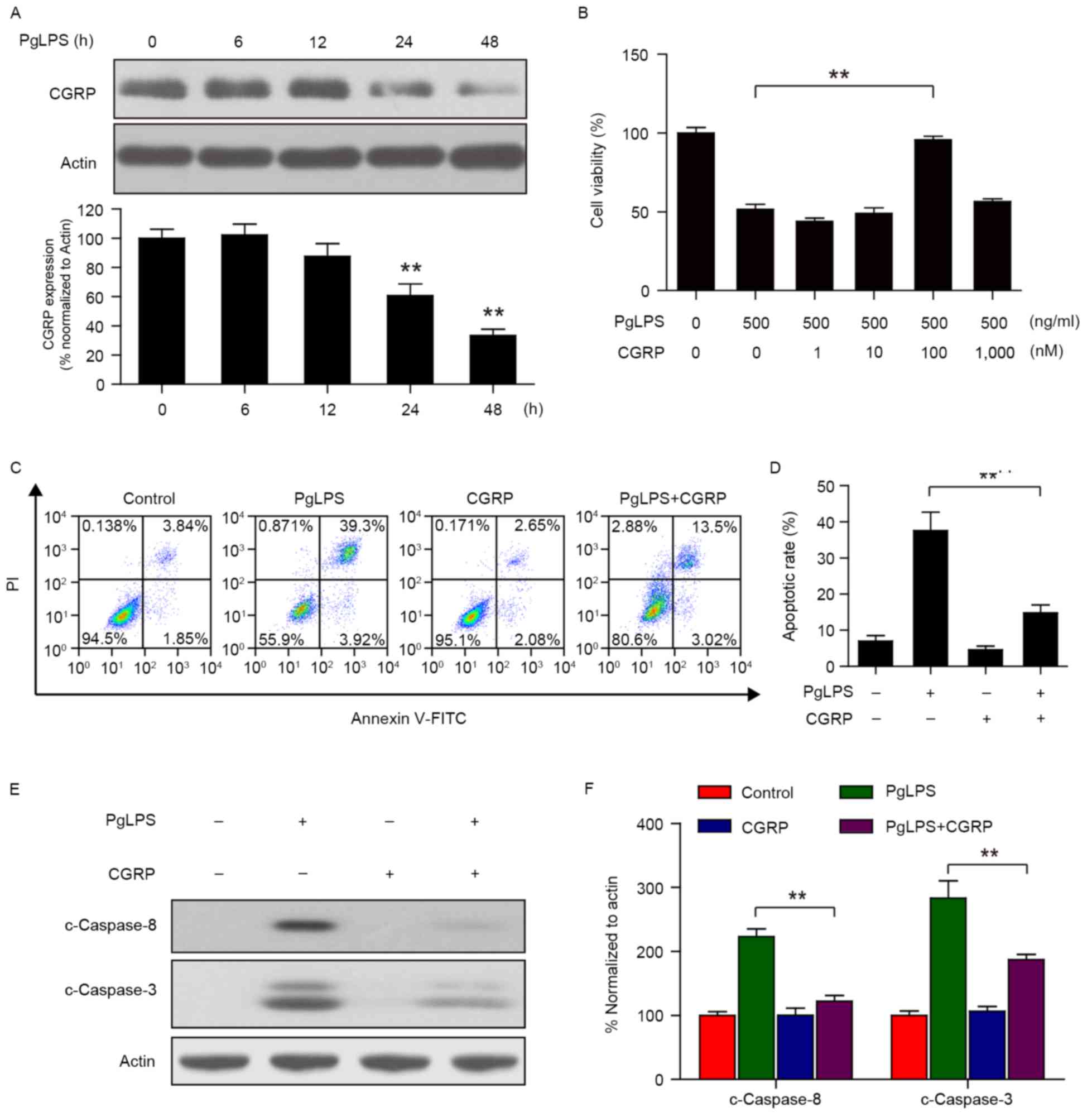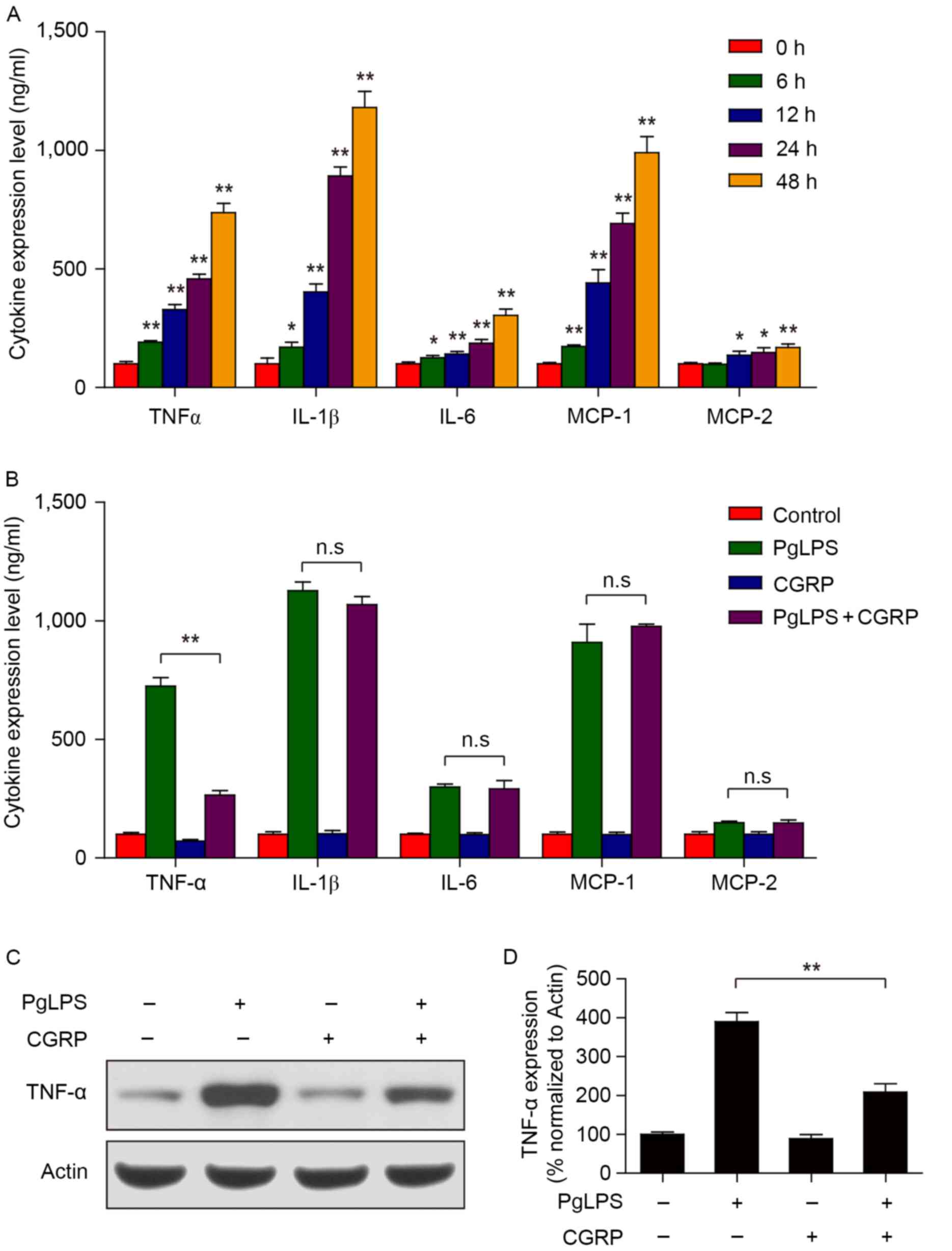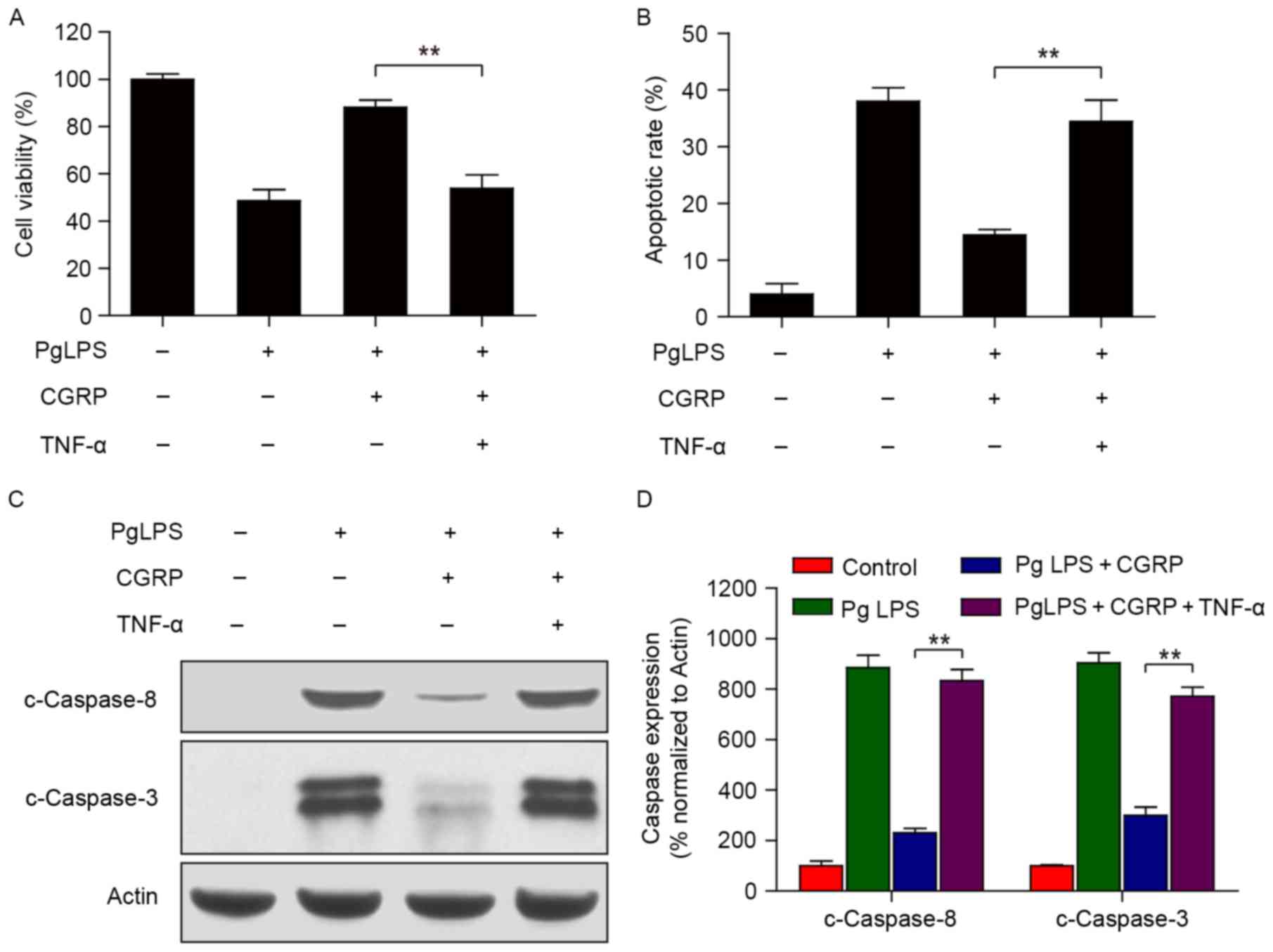|
1
|
Boyce BF, Rosenberg E, de Papp AE and
Duong LT: The osteoclast, bone remodelling and treatment of
metabolic bone disease. Eur J Clin Invest. 42:1332–1341. 2012.
View Article : Google Scholar : PubMed/NCBI
|
|
2
|
Di Benedetto A, Gigante I, Colucci S and
Grano M: Periodontal disease: Linking the primary inflammation to
bone loss. Clin Dev Immunol. 2013:5037542013. View Article : Google Scholar : PubMed/NCBI
|
|
3
|
Song B, Zhou T, Yang WL, Liu J and Shao
LQ: Programmed cell death in periodontitis: Recent advances and
future perspectives. Oral Dis. 23:609–619. 2017. View Article : Google Scholar : PubMed/NCBI
|
|
4
|
Nakao J, Fujii Y, Kusuyama J, Bandow K,
Kakimoto K, Ohnishi T and Matsuguchi T: Low-intensity pulsed
ultrasound (LIPUS) inhibits LPS-induced inflammatory responses of
osteoblasts through TLR4-MyD88 dissociation. Bone. 58:17–25. 2014.
View Article : Google Scholar : PubMed/NCBI
|
|
5
|
Ossola CA, Surkin PN, Pugnaloni A, Mohn
CE, Elverdin JC and Fernandez-Solari J: Long-term treatment with
methanandamide attenuates LPS-induced periodontitis in rats.
Inflamm Res. 61:941–948. 2012. View Article : Google Scholar : PubMed/NCBI
|
|
6
|
Bandow K, Maeda A, Kakimoto K, Kusuyama J,
Shamoto M, Ohnishi T and Matsuguchi T: Molecular mechanisms of the
inhibitory effect of lipopolysaccharide (LPS) on osteoblast
differentiation. Biochem Biophys Res Commun. 402:755–761. 2010.
View Article : Google Scholar : PubMed/NCBI
|
|
7
|
Kadono H, Kido J, Kataoka M, Yamauchi N
and Nagata T: Inhibition of osteoblastic cell differentiation by
lipopolysaccharide extract from Porphyromonas gingivalis. Infect
Immun. 67:2841–2846. 1999.PubMed/NCBI
|
|
8
|
Kato H, Taguchi Y, Tominaga K, Umeda M and
Tanaka A: Porphyromonas gingivalis LPS inhibits osteoblastic
differentiation and promotes pro-inflammatory cytokine production
in human periodontal ligament stem cells. Arch Oral Biol.
59:167–175. 2014. View Article : Google Scholar : PubMed/NCBI
|
|
9
|
Li Y, Shibata Y, Zhang L, Kuboyama N and
Abiko Y: Periodontal pathogen aggregatibacter actinomycetemcomitans
LPS induces mitochondria-dependent-apoptosis in human placental
trophoblasts. Placenta. 32:11–19. 2011. View Article : Google Scholar : PubMed/NCBI
|
|
10
|
Thammasitboon K, Goldring SR and Boch JA:
Role of macrophages in LPS-induced osteoblast and PDL cell
apoptosis. Bone. 38:845–852. 2006. View Article : Google Scholar : PubMed/NCBI
|
|
11
|
Melvin KE, Miller HH and Tashjian AH Jr:
Early diagnosis of medullary carcinoma of the thyroid gland by
means of calcitonin assay. N Engl J Med. 285:1115–1120. 1971.
View Article : Google Scholar : PubMed/NCBI
|
|
12
|
Broad PM, Symes AJ, Thakker RV and Craig
RK: Structure and methylation of the human calcitonin/alpha-CGRP
gene. Nucleic Acids Res. 17:6999–7011. 1989. View Article : Google Scholar : PubMed/NCBI
|
|
13
|
Baillie LD, Schmidhammer H and Mulligan
SJ: Peripheral mu-opioid receptor mediated inhibition of calcium
signaling and action potential-evoked calcium fluorescent
transients in primary afferent CGRP nociceptive terminals.
Neuropharmacology. 93:267–273. 2015. View Article : Google Scholar : PubMed/NCBI
|
|
14
|
Pereira RT, Costa LS, Oliveira IR, Araújo
JC, Aerts M, Vigliano FA and Rosa PV: Relative distribution of
gastrin-, CCK-8-, NPY- and CGRP-immunoreactive cells in the
digestive tract of dorado (Salminus brasiliensis). Tissue Cell.
47:123–131. 2015. View Article : Google Scholar : PubMed/NCBI
|
|
15
|
Uddman R, Luts A and Sundler F: Occurrence
and distribution of calcitonin gene-related peptide in the
mammalian respiratory tract and middle ear. Cell Tissue Res.
241:551–555. 1985. View Article : Google Scholar : PubMed/NCBI
|
|
16
|
Sun T, Guo Z, Liu CJ, Li MR, Li TP, Wang X
and Yuan DJ: Preservation of CGRP in myocardium attenuates
development of cardiac dysfunction in diabetic rats. Int J Cardiol.
220:226–234. 2016. View Article : Google Scholar : PubMed/NCBI
|
|
17
|
He H, Chai J, Zhang S, Ding L, Yan P, Du W
and Yang Z: CGRP may regulate bone metabolism through stimulating
osteoblast differentiation and inhibiting osteoclast formation. Mol
Med Rep. 13:3977–3984. 2016. View Article : Google Scholar : PubMed/NCBI
|
|
18
|
Tian G, Zhang G and Tan YH: Calcitonin
gene-related peptide stimulates BMP-2 expression and the
differentiation of human osteoblast-like cells in vitro. Acta
Pharmacol Sin. 34:1467–1474. 2013. View Article : Google Scholar : PubMed/NCBI
|
|
19
|
Holzmann B: Modulation of immune responses
by the neuropeptide CGRP. Amino Acids. 45:1–7. 2013. View Article : Google Scholar : PubMed/NCBI
|
|
20
|
Holzmann B: Antiinflammatory activities of
CGRP modulating innate immune responses in health and disease. Curr
Protein Pept Sci. 14:268–274. 2013. View Article : Google Scholar : PubMed/NCBI
|
|
21
|
Streilein JW: Ocular immune privilege:
Therapeutic opportunities from an experiment of nature. Nat Rev
Immunol. 3:879–889. 2003. View
Article : Google Scholar : PubMed/NCBI
|
|
22
|
Carucci JA, Ignatius R, Wei Y, Cypess AM,
Schaer DA, Pope M, Steinman RM and Mojsov S: Calcitonin
gene-related peptide decreases expression of HLA-DR and CD86 by
human dendritic cells and dampens dendritic cell-driven T
cell-proliferative responses via the type I calcitonin gene-related
peptide receptor. J Immunol. 164:3494–3499. 2000. View Article : Google Scholar : PubMed/NCBI
|
|
23
|
Harzenetter MD, Novotny AR, Gais P, Molina
CA, Altmayr F and Holzmann B: Negative regulation of TLR responses
by the neuropeptide CGRP is mediated by the transcriptional
repressor ICER. J Immunol. 179:607–615. 2007. View Article : Google Scholar : PubMed/NCBI
|
|
24
|
Nagata S: Apoptosis by death factor. Cell.
88:355–365. 1997. View Article : Google Scholar : PubMed/NCBI
|
|
25
|
Kroeger I, Erhardt A, Abt D, Fischer M,
Biburger M, Rau T, Neuhuber WL and Tiegs G: The neuropeptide
calcitonin gene-related peptide (CGRP) prevents inflammatory liver
injury in mice. J Hepatol. 51:342–353. 2009. View Article : Google Scholar : PubMed/NCBI
|
|
26
|
Orriss IR, Hajjawi MO, Huesa C, MacRae VE
and Arnett TR: Optimisation of the differing conditions required
for bone formation in vitro by primary osteoblasts from mice and
rats. Int J Mol Med. 34:1201–1208. 2014. View Article : Google Scholar : PubMed/NCBI
|
|
27
|
DeLeon-Pennell KY, de Castro Brás LE, Iyer
RP, Bratton DR, Jin YF, Ripplinger CM and Lindsey ML: P. gingivalis
lipopolysaccharide intensifies inflammation post-myocardial
infarction through matrix metalloproteinase-9. J Mol Cell Cardiol.
76:218–226. 2014. View Article : Google Scholar : PubMed/NCBI
|
|
28
|
Ding PH, Darveau RP, Wang CY and Jin L:
3LPS-binding protein and its interactions with P. gingivalis LPS
modulate pro-inflammatory response and toll-like receptor signaling
in human oral keratinocytes. PLoS One. 12:e01732232017. View Article : Google Scholar : PubMed/NCBI
|
|
29
|
Wu X, Feng X, He Y, et al: IL-4
administration exerts preventive effects via suppression of
underlying inflammation and TNF-α-induced apoptosis in
steroid-induced osteonecrosis. Osteoporos Int. 27:1827–1837. 2016.
View Article : Google Scholar : PubMed/NCBI
|
|
30
|
Liang W, Zhuo X, Tang Z, Wei X and Li B:
Calcitonin gene-related peptide stimulates proliferation and
osteogenic differentiation of osteoporotic rat-derived bone
mesenchymal stem cells. Mol Cell Biochem. 402:101–110. 2015.
View Article : Google Scholar : PubMed/NCBI
|
|
31
|
Ma W, Zhang X, Shi S and Zhang Y:
Neuropeptides stimulate human osteoblast activity and promote gap
junctional intercellular communication. Neuropeptides. 47:179–186.
2013. View Article : Google Scholar : PubMed/NCBI
|
|
32
|
Millet I and Vignery A: The neuropeptide
calcitonin gene-related peptide inhibits TNF-alpha but poorly
induces IL-6 production by fetal rat osteoblasts. Cytokine.
9:999–1007. 1997. View Article : Google Scholar : PubMed/NCBI
|
|
33
|
Redlich K and Smolen JS: Inflammatory bone
loss: Pathogenesis and therapeutic intervention. Nat Rev Drug
Discov. 11:234–250. 2012. View
Article : Google Scholar : PubMed/NCBI
|
|
34
|
Guo C, Yuan L, Wang JG, Wang F, Yang XK,
Zhang FH, Song JL, Ma XY, Cheng Q and Song GH: Lipopolysaccharide
(LPS) induces the apoptosis and inhibits osteoblast differentiation
through JNK pathway in MC3T3-E1 cells. Inflammation. 37:621–631.
2014. View Article : Google Scholar : PubMed/NCBI
|
|
35
|
Favaloro B, Allocati N, Graziano V, Di
Ilio C and De Laurenzi V: Role of apoptosis in disease. Aging
(Albany NY). 4:330–349. 2012. View Article : Google Scholar : PubMed/NCBI
|
|
36
|
Meshcheryakova A, Mechtcheriakova D and
Pietschmann P: Sphingosine 1-phosphate signaling in bone
remodeling: Multifaceted roles and therapeutic potential. Expert
Opin Ther Targets. 21:725–737. 2017. View Article : Google Scholar : PubMed/NCBI
|
|
37
|
Kesavalu L, Sathishkumar S, Bakthavatchalu
V, Matthews C, Dawson D, Steffen M and Ebersole JL: Rat model of
polymicrobial infection, immunity and alveolar bone resorption in
periodontal disease. Infect Immun. 75:1704–1712. 2007. View Article : Google Scholar : PubMed/NCBI
|
|
38
|
Bai Y, Wei Y, Wu L, Wei J, Wang X and Bai
Y: C/EBP β mediates endoplasmic reticulum stress regulated
inflammatory response and extracellular matrix degradation in
LPS-stimulated human periodontal ligament cells. Int J Mol Sci.
17:3852016. View Article : Google Scholar : PubMed/NCBI
|
|
39
|
Jaedicke KM, Preshaw PM and Taylor JJ:
Salivary cytokines as biomarkers of periodontal diseases.
Periodontol 2000. 70:164–183. 2016. View Article : Google Scholar : PubMed/NCBI
|
|
40
|
Toyman U, Tuter G, Kurtis B, Kıvrak E,
Bozkurt Ş, Yücel AA and Serdar M: Evaluation of gingival crevicular
fluid levels of tissue plasminogen activator, plasminogen activator
inhibitor 2, matrix metalloproteinase-3 and interleukin 1-β in
patients with different periodontal diseases. J Periodontal Res.
50:44–51. 2015. View Article : Google Scholar : PubMed/NCBI
|
|
41
|
Hou GQ, Guo C, Song GH, Fang N, Fan WJ,
Chen XD, Yuan L and Wang ZQ: Lipopolysaccharide (LPS) promotes
osteoclast differentiation and activation by enhancing the MAPK
pathway and COX-2 expression in RAW264.7 cells. Int J Mol Med.
32:503–510. 2013. View Article : Google Scholar : PubMed/NCBI
|
|
42
|
Guo C, Wang SL, Xu ST, Wang JG and Song
GH: SP600125 reduces lipopolysaccharide-induced apoptosis and
restores the early-stage differentiation of osteoblasts inhibited
by LPS through the MAPK pathway in MC3T3-E1 cells. Int J Mol Med.
35:1427–1434. 2015. View Article : Google Scholar : PubMed/NCBI
|
|
43
|
Kırzıoğlu FY, Tözüm Bulut M, Doğan B,
Fentoğlu Ö, Özmen Ö, Çarsancaklı SA, Ergün AG, Özdem M and Orhan H:
Anti-inflammatory effect of rosuvastatin decreases alveolar bone
loss in experimental periodontitis. J Oral Sci. 59:247–255. 2017.
View Article : Google Scholar : PubMed/NCBI
|
|
44
|
Yao Z, Lei W, Duan R, Li Y, Luo L and
Boyce BF: RANKL cytokine enhances TNF-induced osteoclastogenesis
independently of TNF receptor associated factor (TRAF) 6 by
degrading TRAF3 in osteoclast precursors. J Biol Chem.
292:10169–10179. 2017. View Article : Google Scholar : PubMed/NCBI
|
|
45
|
Tzach-Nahman R, Mizraji G, Shapira L,
Nussbaum G and Wilensky A: Oral infection with porphyromonas
gingivalis induces peri-implantitis in a murine model: Evaluation
of bone loss and the local inflammatory response. J Clin
Periodontol. 44:739–748. 2017. View Article : Google Scholar : PubMed/NCBI
|
|
46
|
Al-Daghri NM, Aziz I, Yakout S, Aljohani
NJ, Al-Saleh Y, Amer OE, Sheshah E, Younis GZ and Al-Badr FB:
Inflammation as a contributing factor among postmenopausal Saudi
women with osteoporosis. Medicine (Baltimore). 96:e57802017.
View Article : Google Scholar : PubMed/NCBI
|
|
47
|
Chen YL, Qiao YC, Xu Y, Ling W, Pan YH,
Huang YC, Geng LJ, Zhao HL and Zhang XX: Serum TNF-α concentrations
in type 2 diabetes mellitus patients and diabetic nephropathy
patients: A systematic review and meta-analysis. Immunol Lett.
186:52–58. 2017. View Article : Google Scholar : PubMed/NCBI
|
|
48
|
Wang C, Yu X, Yan Y, Yang W, Zhang S,
Xiang Y, Zhang J and Wang W: Tumor necrosis factor-alpha: a key
contributor to intervertebral disc degeneration. Acta Biochim
Biophys Sin (Shanghai). 49:1–13. 2017. View Article : Google Scholar : PubMed/NCBI
|
|
49
|
Centrella M, McCarthy TL and Canalis E:
Tumor necrosis factor-alpha inhibits collagen synthesis and
alkaline phosphatase activity independently of its effect on
deoxyribonucleic acid synthesis in osteoblast-enriched bone cell
cultures. Endocrinology. 123:1442–1448. 1988. View Article : Google Scholar : PubMed/NCBI
|
|
50
|
Lam J, Takeshita S, Barker JE, Kanagawa O,
Ross FP and Teitelbaum SL: TNF-alpha induces osteoclastogenesis by
direct stimulation of macrophages exposed to permissive levels of
RANK ligand. J Clin Invest. 106:1481–1488. 2000. View Article : Google Scholar : PubMed/NCBI
|
|
51
|
Park J, Choi HM, Yang HI, Yoo MC and Kim
KS: Increased expression of IL-1 receptors in response to IL-1β may
produce more IL-6, IL-8, VEGF and PGE2 in senescent synovial cells
induced in vitro than in presenescent cells. Rheumatol Int.
32:2005–2010. 2012. View Article : Google Scholar : PubMed/NCBI
|
|
52
|
Santos RS, Macedo RF, Souza EA, Soares RS,
Feitosa DS and Sarmento CF: The use of systemic antibiotics in the
treatment of refractory periodontitis: A systematic review. J Am
Dent Assoc. 147:577–585. 2016. View Article : Google Scholar : PubMed/NCBI
|













